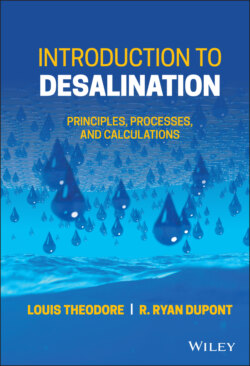Читать книгу Introduction to Desalination - Louis Theodore - Страница 15
1.4 Global Water Resource Issues
ОглавлениеThe root of all major issues pertaining to global water resources today stems from a lack of water accessibility. It is estimated that over 1 billion people live without access to safe water (WHO 2017). This number more than doubles to over 2.3 billion people when basic sanitation services are considered. It is this lack of access to safe drinking water and adequately treated wastewater that drives other major water-related issues in the world today. As indicated earlier, this access issue stems directly from the lack of necessary water infrastructure as well as the poor maintenance and management of the limited infrastructure that currently exists.
Improved water resource management and water storage capacity makes an economy more resilient to external shocks, such as rainfall variability, and thus provides a stable and sustainable base for increased food and industrial productivity and production to maintain economic growth and development. Consider a heavily water-dependent country like Kenya where frequent floods and droughts take a heavy toll on the economy (SIWI 2005). These floods and droughts translate to a direct long-term fiscal liability and decline in economic growth of about 2.4% of Kenya’s annual GDP (SIWI 2005). Much of this loss in economic output comes from lack of adequate water storage capacity, a deficit of more than $10 billion in 2004 (SIWI 2005). If Kenya, as for many other African countries, had invested in storage facilities for water, they would be able to store the excess water received in heavy flood years for use in heavy drought years, thus, avoiding flood liabilities and water scarcity cost, allowing the country to avoid the drops in economic growth that have occurred in the past.
The SIWI (2005) indicated that national economies are more resilient to rainfall variability, and economic growth is increased when water storage capacity is improved. Investing in adequate water resource management in developing countries would be expected to produce significant economic gains of between two to four times the infrastructure investment. The SIWI (2005) concluded that an even greater return on investment of $8.00–$200 would be saved in water treatment costs for every $1.00 invested in watershed protection. Investments in improved water and sanitation infrastructure in developing countries also has significant economic benefits when considering increased productivity from the improved health of workers in households and the commercial and industrial sectors, ranging from hundreds of millions to billions of dollars annually (SIWI 2005).
In today’s world, the term hydro-politics is becoming more and more known. Hydro-politics can be defined as debate or conflict amongst individuals, parties, or organizations within governments about water-related issues. These debates/conflicts may even take place between multiple countries, not just the individuals within those countries. Commonly, these types of conflicts are solved by establishing a system known as Riparian Water Rights. This is a system used to allocate water among different countries or jurisdictions within countries that are in control of the land through which the water travels. These types of rights are considered common law amongst many countries in the world such as the United States, Canada, Australia, and Great Britain.
Even though many of the largest countries in the world have used this system to manage water conflicts for years, there are many other countries where these systems are relatively new. A prime example of this is conflict between Egypt and Ethiopia. For centuries, these two countries have been in constant conflict over who owns the developmental rights for the water in the River Nile. It wasn’t until 2015 that these two counties set aside their differences and signed an agreement ensuring shared and equitable access to the river (Lufkin 2017).
Even with compromises such as the one between Egypt and Ethiopia, some individuals, such as Ismail Serageldin (former Vice President of the World Bank), see water becoming the next so called “Oil War.” Ismail Serageldin famously said, “The wars of this century were fought over oil, the wars of the next century will be fought over water” (Barnaby 2009). However, when one sees countries coming together to solve their water resources conflicts, forming compromises like Egypt and Ethiopia, the potential for water wars seem less likely, and the arguments by Barnaby (2009), Fröhlich (2012), and McCrary (2018) appear to have more validity. These latter authors believe that physical conflict over water will not happen because established systems for international trade and international agreements leading to mutual benefits ease these conflicts, thus preventing the scale of these problems from becoming large enough to cause military style confrontations. Certainly, the expansion of available water supplies through the expansion of desalination technologies will contribute to the reduction in multinational conflicts over water and ensure more adequate water supplies for all peoples.
